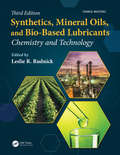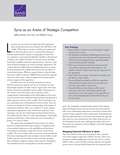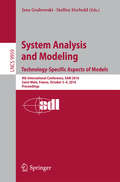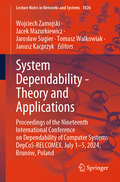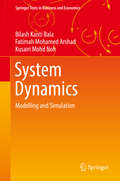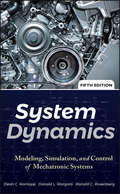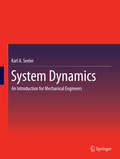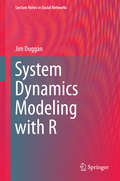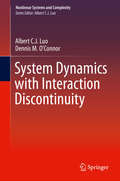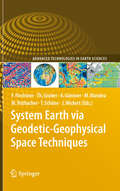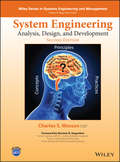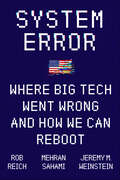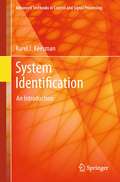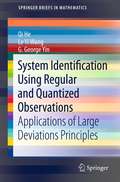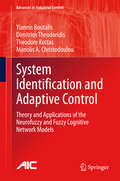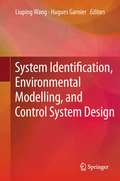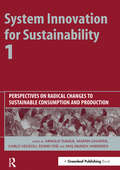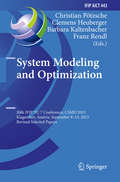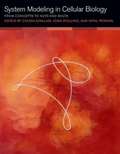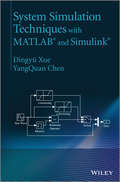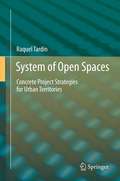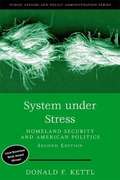- Table View
- List View
Synthetics, Mineral Oils, and Bio-Based Lubricants: Chemistry and Technology (Chemical Industries)
by Leslie R. RudnickHighlighting the major economic and industrial changes in the lubrication industry since the first edition, Synthetics, Mineral Oils, and Bio-Based Lubricants: Chemistry and Technology, Third Edition highlights the major economic and industrial changes in the lubrication industry and outlines the state of the art in each major lubricant application area. Chapters cover the use of lubricant fluids, growth or decline of market areas and applications, potential new applications, production capacities, and regulatory issues, including biodegradability, toxicity, and food production equipment lubrication. The highly-anticipated third edition features new and updated chapters including those on automatic and continuously variable transmission fluids, fluids for food-grade applications, oil-soluble polyalkylene glycols, functional bio-based lubricant base stocks, farnesene-derived polyolefins, estolides, bio-based lubricants from soybean oil, and trends in construction equipment lubrication. Features include: Contains an index of terms, acronyms, and analytical testing methods. Presents the latest conventions for describing upgraded mineral oil base fluids. Considers all the major lubrication areas: engine oils, industrial lubricants, food-grade applications, greases, and space-age applications Includes individual chapters on lubricant applications—such as environmentally friendly, disk drive, and magnetizable fluids—for major market areas around the globe. In a single, unique volume, Synthetics, Mineral Oils, and Bio-Based Lubricants: Chemistry and Technology, Third Edition offers property and performance information of fluids, theoretical and practical background to their current applications, and strong indicators for global market trends that will influence the industry for years to come.
Syria as an Arena of Strategic Competition
by Jeffrey Martini Erin York William YoungLess than two years since the beginning of the uprising in Syria, localized protests have morphed into full-blown civil conflict, and external actors have become involved as well. RAND conducted an analytic exercise to generate a greater understanding of the parties and issues in play, including the actors, their motivations, and potential impact of their activities.
System Analysis and Modeling. Technology-Specific Aspects of Models
by Jens Grabowski Steffen HerboldThis book constitutes revised papers of the proceedings of the 9th International Workshop on System Analysis and Modeling, SAM 2016, held in Saint-Melo, France, in October 2016. The 15 full papers presented were carefully reviewed and selected from 31 submissions. The contributions are organized in topical theme named: Technology-Specific Aspects of Models. The volume reflects the five sessions of the conference. The first two sessions are closely aligned with the conference theme with a session on the Internet of Things and a session on Technology-specific Aspects. The other three sessions cover aspects regarding modeling languages and model-driven development in general and were organized in the sessions Languages, Configurations and Features, and Patterns and Compilation.
System Dependability - Theory and Applications: Proceedings of the Nineteenth International Conference on Dependability of Computer Systems DepCoS-RELCOMEX. July 1–5, 2024, Brunów, Poland (Lecture Notes in Networks and Systems #1026)
by Janusz Kacprzyk Wojciech Zamojski Jacek Mazurkiewicz Jarosław Sugier Tomasz WalkowiakThis book presents a selection of papers about problems which arise in dependability studies of contemporary computer systems and networks. Their collection should be an interesting and inspiring source material for scientists, researchers, engineers, and students who must consider diverse dependability characteristics in design, analysis, or maintenance of computer systems and networks. The papers were presented during the 19th DepCoS-RELCOMEX conference which was the next event in a series organized annually since 2006. Originating as a scientific platform for discussions of reliability aspects in computer engineering, the topical scope of the conference has been constantly expanded to incorporate new dependability challenges brought by recent advances in systems and information technologies. Currently, dependable operation in the context of computer processing means obtaining reliable (true and timely) results in the conditions of processing both quantitative and qualitative data, using precise or fuzzy (often: imitating) models and algorithms. With increasing use of artificial intelligence algorithms and tools, dependability in contemporary information technology and computer engineering calls for methods based on cognitive systems and deep learning techniques. Topical variety of the papers included in these proceedings proves that almost all applications of modern computer systems and networks must take into account the aspect of dependability and also illustrates a wide diversity of multidisciplinary subjects which needs to be considered in this context.
System Dynamics
by Bilash Kanti Bala Fatimah Mohamed Arshad Kusairi Mohd NohThis book covers the broad spectrum of system dynamics methodologies for the modelling and simulation of complex systems: systems thinking, causal diagrams, systems structure of stock and flow diagrams, parameter estimation and tests for confidence building in system dynamics models. It includes a comprehensive review of model validation and policy design and provides a practical presentation of system dynamics modelling. It also offers numerous worked-out examples and case studies in diverse fields using STELLA and VENSIM. The system dynamics methodologies presented here can be applied to nearly all areas of research and planning, and the simulations provided make the complicated issues more easily understandable. System Dynamics: Modelling and Simulation is an essential system dynamics and systems engineering textbook for undergraduate and graduate courses. It also offers an excellent reference guide for managers in industry and policy planners who wish to use modelling and simulation to manage complex systems more effectively, as well as researchers in the fields of modelling and simulation-based systems thinking.
System Dynamics
by Donald L. Margolis Ronald C. Rosenberg Dean C. KarnoppAn expanded new edition of the bestselling system dynamics book using the bond graph approachA major revision of the go-to resource for engineers facing the increasingly complex job of dynamic systems design, System Dynamics, Fifth Edition adds a completely new section on the control of mechatronic systems, while revising and clarifying material on modeling and computer simulation for a wide variety of physical systems.This new edition continues to offer comprehensive, up-to-date coverage of bond graphs, using these important design tools to help readers better understand the various components of dynamic systems. Covering all topics from the ground up, the book provides step-by-step guidance on how to leverage the power of bond graphs to model the flow of information and energy in all types of engineering systems. It begins with simple bond graph models of mechanical, electrical, and hydraulic systems, then goes on to explain in detail how to model more complex systems using computer simulations. Readers will find:New material and practical advice on the design of control systems using mathematical modelsNew chapters on methods that go beyond predicting system behavior, including automatic control, observers, parameter studies for system design, and concept testingCoverage of electromechanical transducers and mechanical systems in plane motionFormulas for computing hydraulic compliances and modeling acoustic systemsA discussion of state-of-the-art simulation tools such as MATLAB and bond graph softwareComplete with numerous figures and examples, System Dynamics, Fifth Edition is a must-have resource for anyone designing systems and components in the automotive, aerospace, and defense industries. It is also an excellent hands-on guide on the latest bond graph methods for readers unfamiliar with physical system modeling.
System Dynamics
by Karl A. SeelerThis unique textbook takes the student from the initial steps in modeling a dynamic system through development of the mathematical models needed for feedback control. The generously-illustrated, student-friendly text focuses on fundamental theoretical development rather than the application of commercial software. Practical details of machine design are included to motivate the non-mathematically inclined student.
System Dynamics Modeling with R
by Jim DugganThis new interdisciplinary work presents system dynamics as a powerful approach to enable analysts build simulation models of social systems, with a view toward enhancing decision making. Grounded in the feedback perspective of complex systems, the book provides a practical introduction to system dynamics, and covers key concepts such as stocks, flows, and feedback. Societal challenges such as predicting the impact of an emerging infectious disease, estimating population growth, and assessing the capacity of health services to cope with demographic change can all benefit from the application of computer simulation. This text explains important building blocks of the system dynamics approach, including material delays, stock management heuristics, and how to model effects between different systemic elements. Models from epidemiology, health systems, and economics are presented to illuminate important ideas, and the R programming language is used to provide an open-source and interoperable way to build system dynamics models. System Dynamics Modeling with R also describes hands-on techniques that can enhance client confidence in system dynamic models, including model testing, model analysis, and calibration. Developed from the author's course in system dynamics, this book is written for undergraduate and postgraduate students of management, operations research, computer science, and applied mathematics. Its focus is on the fundamental building blocks of system dynamics models, and its choice of R as a modeling language make it an ideal reference text for those wishing to integrate system dynamics modeling with related data analytic methods and techniques.
System Dynamics for Mechanical Engineers
by Tony L. Schmitz Matthew A. DaviesThis textbook is ideal for mechanical engineering students preparing to enter the workforce during a time of rapidly accelerating technology, where they will be challenged to join interdisciplinary teams. It explains system dynamics using analogies familiar to the mechanical engineer while introducing new content in an intuitive fashion. The fundamentals provided in this book prepare the mechanical engineer to adapt to continuous technological advances with topics outside traditional mechanical engineering curricula by preparing them to apply basic principles and established approaches to new problems. This book also: · Reinforces the connection between the subject matter and engineering reality · Includes an instructor pack with the online publication that describes in-class experiments with minimal preparation requirements · Provides content dedicated to the modeling of modern interdisciplinary technological subjects, including opto-mechanical systems, high-speed manufacturing equipment, and measurement systems · Incorporates MATLAB® programming examples throughout the text · Incorporates MATLAB® examples that animate the dynamics of systems
System Dynamics with Interaction Discontinuity
by Albert C. J. Luo Dennis M. O'ConnorThis book describes system dynamics with discontinuity caused by system interactions and presents the theory of flow singularity and switchability at the boundary in discontinuous dynamical systems. Based on such a theory, the authors address dynamics and motion mechanism of engineering discontinuous systems due to interaction. Stability and bifurcations of fixed points in nonlinear discrete dynamical systems are presented, and mapping dynamics are developed for analytical predictions of periodic motions in engineering discontinuous dynamical systems. Ultimately, the book provides an alternative way to discuss the periodic and chaotic behaviors in discontinuous dynamical systems.
System Earth via Geodetic-Geophysical Space Techniques
by Frank M. Flechtner Jens Wickert Markus Rothacher Thomas Gruber M. Mandea Andreas Güntner Tilo SchöneThe Earth's magnetic and gravity field play an important role in global and regional geodynamics. Satellite exploration of these fields has received great attention in recent years. Research satellites such as CHAMP and GRACE as well as the ESA explorer GOCE apply new measurement techniques, thus allowing the recovery of the gravitational and magnetic field with unprecedented accuracy and resolution, spatial as well as temporal. Combined with terrestrial observations and computer models, this data will help develop a more detailed understanding of the Earth as a system. In Germany, many of the processing, modelling and interpreting methodologies for these new observation techniques are developed under the umbrella of the R&D-programme GEOTECHNOLOGIEN, funded by the Federal Ministry of Education and Research (BMBF). The research projects focus on a better understanding of the spatial and temporal variations in the magnetic and gravity field and their relationship to the dynamics of the Earth's interior and global change processes. This volume presents the results of the multidisciplinary studies covered by the programme for the period 2005-2008. It includes the following topics: High-accuracy gravity field models, near-real-time provision and usage of CHAMP and GRACE atmospheric sounding, sea level variations, improved GRACE gravity time series and their validation by ocean bottom pressure measurements, integration of space geodetic techniques as a basis for the Global Geodetic-Geophysical Observing System (GGOS), high-resolution magnetic field models and global magnetisation maps and time-variable gravity and surface mass processes.
System Engineering Analysis, Design, and Development: Concepts, Principles, and Practices (Second Edition)
by Charles S. WassonThis textbook presents a comprehensive, step-by-step guide to System Engineering analysis, design, and development via an integrated set of concepts, principles, practices, and methodologies. The methods presented in this text apply to any type of human system -- small, medium, and large organizational systems and system development projects delivering engineered systems or services across multiple business sectors such as medical, transportation, financial, educational, governmental, aerospace and defense, utilities, political, and charity, among others. Thoroughly illustrated, with end-of-chapter exercises and numerous case studies and examples, Systems Engineering Analysis, Design, and Development, Second Edition is a primary textbook for multi-discipline, engineering, system analysis, and project management undergraduate/graduate level students and a valuable reference for professionals.
System Error: Where Big Tech Went Wrong and How We Can Reboot
by Rob Reich Jeremy M. Weinstein Mehran Sahami"System Error is a triumph: an analysis of the critical challenges facing our digital society that is as accessible as it is sophisticated." — Anne-Marie Slaughter, CEO of New AmericaA forward-thinking manifesto from three Stanford professors—experts who have worked at ground zero of the tech revolution for decades—which reveals how big tech’s obsession with optimization and efficiency has sacrificed fundamental human values and outlines steps we can take to change course, renew our democracy, and save ourselves.In no more than the blink of an eye, a naïve optimism about technology’s liberating potential has given way to a dystopian obsession with biased algorithms, surveillance capitalism, and job-displacing robots. Yet too few of us see any alternative to accepting the onward march of technology. We have simply accepted a technological future designed for us by technologists, the venture capitalists who fund them, and the politicians who give them free rein.It doesn’t need to be this way.System Error exposes the root of our current predicament: how big tech’s relentless focus on optimization is driving a future that reinforces discrimination, erodes privacy, displaces workers, and pollutes the information we get. This optimization mindset substitutes what companies care about for the values that we as a democratic society might choose to prioritize. Well-intentioned optimizers fail to measure all that is meaningful and, when their creative disruptions achieve great scale, they impose their values upon the rest of us.Armed with an understanding of how technologists think and exercise their power, three Stanford professors—a philosopher working at the intersection of tech and ethics, a political scientist who served under Obama, and the director of the undergraduate Computer Science program at Stanford (also an early Google engineer)—reveal how we can hold that power to account.Troubled by the values that permeate the university’s student body and its culture, they worked together to chart a new path forward, creating a popular course to transform how tomorrow’s technologists approach their profession. Now, as the dominance of big tech becomes an explosive societal conundrum, they share their provocative insights and concrete solutions to help everyone understand what is happening, what is at stake, and what we can do to control technology instead of letting it control us.
System Identification
by Karel J. KeesmanSystem Identification shows the student reader how to approach the system identification problem in a systematic fashion. The process is divided into three basic steps: experimental design and data collection; model structure selection and parameter estimation; and model validation, each of which is the subject of one or more parts of the text. Following an introduction on system theory, particularly in relation to model representation and model properties, the book contains four parts covering: * data-based identification - non-parametric methods for use when prior system knowledge is very limited; * time-invariant identification for systems with constant parameters; * time-varying systems identification, primarily with recursive estimation techniques; and * model validation methods. A fifth part, composed of appendices, covers the various aspects of the underlying mathematics needed to begin using the text. The book uses essentially semi-physical or gray-box modeling methods although data-based, transfer-function system descriptions are also introduced. The approach is problem-based rather than rigorously mathematical. The use of finite input-output data is demonstrated for frequency- and time-domain identification in static, dynamic, linear, nonlinear, time-invariant and time-varying systems. Simple examples are used to show readers how to perform and emulate the identification steps involved in various control design methods with more complex illustrations derived from real physical, chemical and biological applications being used to demonstrate the practical applicability of the methods described. End-of-chapter exercises (for which a downloadable instructors' Solutions Manual is available from fill in URL here) will both help students to assimilate what they have learned and make the book suitable for self-tuition by practitioners looking to brush up on modern techniques. Graduate and final-year undergraduate students will find this text to be a practical and realistic course in system identification that can be used for assessing the processes of a variety of engineering disciplines. System Identification will help academic instructors teaching control-related to give their students a good understanding of identification methods that can be used in the real world without the encumbrance of undue mathematical detail.
System Identification Using Regular and Quantized Observations
by Le Yi Wang George G. Yin Qi HeThis brief presents characterizations of identification errors under a probabilistic framework when output sensors are binary, quantized, or regular. By considering both space complexity in terms of signal quantization and time complexity with respect to data window sizes, this study provides a new perspective to understand the fundamental relationship between probabilistic errors and resources, which may represent data sizes in computer usage, computational complexity in algorithms, sample sizes in statistical analysis and channel bandwidths in communications.
System Identification and Adaptive Control
by Yiannis Boutalis Dimitrios Theodoridis Theodore Kottas Manolis A. ChristodoulouPresenting current trends in the development and applications of intelligent systems in engineering, this monograph focuses on recent research results in system identification and control. The recurrent neurofuzzy and the fuzzy cognitive network (FCN) models are presented Both models are suitable for partially-known or unknown complex time-varying systems. Neurofuzzy Adaptive Control contains rigorous proofs of its statements which result in concrete conclusions for the selection of the design parameters of the algorithms presented. The neurofuzzy model combines concepts from fuzzy systems and recurrent high-order neural networks to produce powerful system approximations that are used for adaptive control. The FCN model stems from fuzzy cognitive maps and uses the notion of "concepts" and their causal relationships to capture the behavior of complex systems. The book shows how, with the benefit of proper training algorithms, these models are potent system emulators suitable for use in engineering systems All chapters are supported by illustrative simulation experiments, while separate chapters are devoted to the potential industrial applications of each model including projects in: * contemporary power generation; * process control and * conventional benchmarking problems. Researchers and graduate students working in adaptive estimation and intelligent control will find Neurofuzzy Adaptive Control of interest both for the currency of its models and because it demonstrates their relevance for real systems. The monograph also shows industrial engineers how to test intelligent adaptive control easily using proven theoretical results.
System Identification, Environmental Modelling, and Control System Design
by Hugues Garnier Liuping WangThis book is dedicated to Prof. Peter Young on his 70th birthday. Professor Young has been a pioneer in systems and control, and over the past 45 years he has influenced many developments in this field. This volume comprises a collection of contributions by leading experts in system identification, time-series analysis, environmetric modelling and control system design - modern research in topics that reflect important areas of interest in Professor Young's research career. Recent theoretical developments in and relevant applications of these areas are explored treating the various subjects broadly and in depth. The authoritative and up-to-date research presented here will be of interest to academic researcher in control and disciplines related to environmental research, particularly those to with water systems. The tutorial style in which many of the contributions are composed also makes the book suitable as a source of study material for graduate students in those areas.
System Innovation for Sustainability 1: Perspectives on Radical Changes to Sustainable Consumption and Production
by Carlo Vezzoli Martin Charter Eivind Stø Arnold Tukker Maj Munch AndersenSustainable consumption and production (SCP) was adopted as a priority area during the World Summit on Sustainable Development in Johannesburg in 2002 and has since become one of the main vehicles for targeting international sustainability policy. Sustainable consumption focuses on formulating equitable strategies that foster the highest quality of life, the efficient use of natural resources, and the effective satisfaction of human needs while simultaneously promoting equitable social development, economic competitiveness, and technological innovation. But this is a complex topic and, as the challenges of sustainability grow larger, there is a need to re-imagine how SCP policies can be formulated, governed and implemented. The EU-funded project "Sustainable Consumption Research Exchanges" (SCORE!) consists of around 200 experts in the field of sustainable innovation and sustainable consumption. The SCORE! philosophy is that innovation in SCP policy can be achieved only if experts that understand business development, (sustainable) solution design, consumer behaviour and system innovation policy work together in shaping it. Sustainable technology design can be effective only if business can profitably make the products and consumers are attracted to them. To understand how this might effectively happen, the expertise of systems thinkers must be added to the mix. System Innovation for Sustainability 1 is the first result of a unique positive confrontation between experts from all four communities. It examines what SCP is and what it could be, provides a state-of-the-art review on the governance of change in SCP policy and looks at the strengths and weaknesses of current approaches. The SCORE! experts are working with actors in industry, consumer groups and eco-labelling organisations in the key consumption areas of mobility, food and agriculture, and energy use and housing – responsible for 70% of the life-cycle environmental impacts of Western societies – with the aim of stimulating, fostering or forcing change to SCP theory in practice. The System Innovation for Sustainability series will continue with three further volumes of comprehensive case studies in each of these three critical consumption areas. Each chapter of this book examines problems and suggests solutions from a business, design, consumer and system innovation perspective. It primarily examines the differing solutions necessary in the consumer economies of the West, but also comments on the differing needs in rapidly emerging economies such as China, as well as base-of-the-pyramid economies. The System Innovation for Sustainability series is the fruit of the only major international research network on SCP and will set the standard in this field for some years to come. It will be required reading for all involved in the policy debate on sustainable production and consumption from government, business, academia and NGOs for designers, scientists, businesses and system innovators.
System Level ESD Protection
by Vladislav Vashchenko Mirko ScholzThis book addresses key aspects of analog integrated circuits and systems design related to system level electrostatic discharge (ESD) protection. It is an invaluable reference for anyone developing systems-on-chip (SoC) and systems-on-package (SoP), integrated with system-level ESD protection. The book focuses on both the design of semiconductor integrated circuit (IC) components with embedded, on-chip system level protection and IC-system co-design. The readers will be enabled to bring the system level ESD protection solutions to the level of integrated circuits, thereby reducing or completely eliminating the need for additional, discrete components on the printed circuit board (PCB) and meeting system-level ESD requirements. The authors take a systematic approach, based on IC-system ESD protection co-design. A detailed description of the available IC-level ESD testing methods is provided, together with a discussion of the correlation between IC-level and system-level ESD testing methods. The IC-level ESD protection design is demonstrated with representative case studies which are analyzed with various numerical simulations and ESD testing. The overall methodology for IC-system ESD co-design is presented as a step-by-step procedure that involves both ESD testing and numerical simulations.
System Lightweight Design for Aviation (essentials)
by Martin WiedemannThis open access book presents technologies and methods of lightweight system design to support future low-emission aviation in achieving climate targets. It will be shown how reduction of weight and aerodynamic drag affects the energy consumption of commercial aircraft and what characterizes lightweight system design. Methods, design principles, production technologies and options for functional integration are available for more energy-efficient aircraft. Research results from the last decade are presented, which are intended to encourage the reader to further research and, above all, to implement them in future aircraft.
System Modeling and Optimization
by Christian Pötzsche Clemens Heuberger Barbara Kaltenbacher Franz RendlThis book is a collection of thoroughly refereed papers presented at the 26th IFIP TC 7 Conference on System Modeling and Optimization, held in Klagenfurt, Austria, in September 2013. The 34 revised papers were carefully selected from numerous submissions. They cover the latest progress in a wide range of topics such as optimal control of ordinary and partial differential equations, modeling and simulation, inverse problems, nonlinear, discrete, and stochastic optimization as well as industrial applications.
System Modeling in Cell Biology: From Concepts to Nuts and Bolts
by Zoltan Szallasi Vipul Periwal Jorg StellingResearch in systems biology requires the collaboration of researchers from diverse backgrounds, including biology, computer science, mathematics, statistics, physics, and biochemistry. These collaborations, necessary because of the enormous breadth of background needed for research in this field, can be hindered by differing understandings of the limitations and applicability of techniques and concerns from different disciplines. This comprehensive introduction and overview of system modeling in biology makes the relevant background material from all pertinent fields accessible to researchers with different backgrounds. The emerging area of systems level modeling in cellular biology has lacked a critical and thorough overview. This book fills that gap. It is the first to provide the necessary critical comparison of concepts and approaches, with an emphasis on their possible applications. It presents key concepts and their theoretical background, including the concepts of robustness and modularity and their exploitation to study biological systems; the best-known modeling approaches, and their advantages and disadvantages; lessons from the application of mathematical models to the study of cellular biology; and available modeling tools and datasets, along with their computational limitations.
System Simulation Techniques with MATLAB and Simulink
by Yangquan Chen Dingyü XueSystem Simulation Techniques with MATLAB and Simulink comprehensively explains how to use MATLAB and Simulink to perform dynamic systems simulation tasks for engineering and non-engineering applications.This book begins with covering the fundamentals of MATLAB programming and applications, and the solutions to different mathematical problems in simulation. The fundamentals of Simulink modelling and simulation are then presented, followed by coverage of intermediate level modelling skills and more advanced techniques in Simulink modelling and applications.Finally the modelling and simulation of engineering and non-engineering systems are presented. The areas covered include electrical, electronic systems, mechanical systems, pharmacokinetic systems, video and image processing systems and discrete event systems. Hardware-in-the-loop simulation and real-time application are also discussed.Key features:Progressive building of simulation skills using Simulink, from basics through to advanced levels, with illustrations and examplesWide coverage of simulation topics of applications from engineering to non-engineering systemsDedicated chapter on hardware-in-the-loop simulation and real time controlEnd of chapter exercisesA companion website hosting a solution manual and powerpoint slidesSystem Simulation Techniques with MATLAB and Simulink is a suitable textbook for senior undergraduate/postgraduate courses covering modelling and simulation, and is also an ideal reference for researchers and practitioners in industry.
System of Open Spaces
by Raquel TardinIn the current panorama of urban growth and planning in many urban territories of western societies, open spaces are residual spaces of urban occupation or are reserved for eventual occupation. Open spaces have been viewed in this manner in the earlier stages of the compact city and especially now, in a time of the dispersed territories characterized by discontinuity, heterogeneity, and fragmentation. The disciplinary perspectives of ecology, geology, landscape architecture, and urbanism, but also public opinion, have for some time promoted the conservation and protection of the most valuable natural spaces, and efforts have been made to remove such spaces from the real estate market. However, such positions, usually radical, are insufficient for territorial equilibrium and inevitably lead to the progressive disappearance of valuable natural spaces.
System under Stress: Homeland Security and American Politics
by Donald F. KettlFor the purposes of the study of American government, suggests Kettl (political science, U. of Pennsylvania), the 9-11 terrorist attacks and the Hurricane Katrina disaster were "stress tests" analogous to those run by a cardiologist to diagnose the health of a patient's heart. He offers his own diagnosis of the US government's homeland security health as revealed by these events, discussing intelligence failures prior to the 9-11 attacks and the government's response, broader coordination problems in the federal bureaucracy, state and local government responses to Hurricane Katrina, the policy problem of trying to maximize protection against threats that can't be eliminated, and the alleged conflict between security and civil rights and liberties. Annotation ©2007 Book News, Inc., Portland, OR (booknews.com)
